Predicting Particle Size and Soil Organic Carbon of Soil Profiles Using VIS-NIR-SWIR Hyperspectral Imaging and Machine Learning Models
Abstract
1. Introduction
2. Material and Methods
2.1. Sample Collection and Preparation
2.2. Spectroscopic Measurement and Preprocessing
2.2.1. VIS-NIR and SWIR Spectral Measurements by Imaging Sensors
2.2.2. VIS-NIR-SWIR Spectral Measurements by Non-Imaging Sensor
2.3. Data Modeling
Prediction of Soil Attributes Based on ML Models and Spectral Signature Obtained by Imaging Sensors and Non-Imaging Sensor
3. Results
3.1. Descriptive Analysis of Soil Spectral Behavior
3.2. Soil Attributes Prediction Based on ML Models and VIS-NIR Hyperspectral Reflectance Obtained by Imaging Sensor
3.3. Soil Attributes Prediction Based on ML Models and SWIR Hyperspectral Reflectance Obtained by Imaging Sensor
3.4. Soil Attributes Prediction Based on ML Models and VIS-NIR-SWIR Hyperspectral Reflectance Obtained by Non-Imaging Sensor
4. Discussion
4.1. Soil Spectral Behavior
4.2. Soil Attributes Prediction Based on ML Models and Hyperspectral Reflectance
4.3. Performance of VIS-NIR, SWIR, and VIS-NIR-SWIR Wavelengths in Predicting Soil Attributes
5. Conclusions
Author Contributions
Funding
Data Availability Statement
Acknowledgments
Conflicts of Interest
References
- Coblinski, J.A.; Giasson, É.; Demattê, J.A.M.; Dotto, A.C.; Costa, J.J.F.; Vašát, R. Prediction of Soil Texture Classes through Different Wavelength Regions of Reflectance Spectroscopy at Various Soil Depths. Catena 2020, 189, 104485. [Google Scholar] [CrossRef]
- Liu, F.; Zhang, G.-L.; Song, X.; Li, D.; Zhao, Y.; Yang, J.; Wu, H.; Yang, F. High-Resolution and Three-Dimensional Mapping of Soil Texture of China. Geoderma 2020, 361, 114061. [Google Scholar] [CrossRef]
- Ben-Dor, E.; Chabrillat, S.; Demattê, J.A.M.; Taylor, G.R.; Hill, J.; Whiting, M.L.; Sommer, S. Using Imaging Spectroscopy to Study Soil Properties. Remote Sens. Environ. 2009, 113, S38–S55. [Google Scholar] [CrossRef]
- Sorenson, P.T.; Quideau, S.A.; Rivard, B.; Dyck, M. Distribution Mapping of Soil Profile Carbon and Nitrogen with Laboratory Imaging Spectroscopy. Geoderma 2020, 359, 113982. [Google Scholar] [CrossRef]
- Teixeira, P.C.; Donagemma, G.K.; Fontana, A.; Teixeira, W.G. Manual de Métodos de Análise de Solo, 3rd ed.; Embrapa: Brasília, Brazil, 2017. [Google Scholar]
- Castaldi, F.; Palombo, A.; Santini, F.; Pascucci, S.; Pignatti, S.; Casa, R. Evaluation of the Potential of the Current and Forthcoming Multispectral and Hyperspectral Imagers to Estimate Soil Texture and Organic Carbon. Remote Sens. Environ. 2016, 179, 54–65. [Google Scholar] [CrossRef]
- da Silva Chagas, C.; de Carvalho, W., Jr.; Bhering, S.B.; Calderano Filho, B. Spatial Prediction of Soil Surface Texture in a Semiarid Region Using Random Forest and Multiple Linear Regressions. Catena 2016, 139, 232–240. [Google Scholar] [CrossRef]
- Rawlins, B.G.; Kemp, S.J.; Milodowski, A.E. Relationships between Particle Size Distribution and VNIR Reflectance Spectra Are Weaker for Soils Formed from Bedrock Compared to Transported Parent Materials. Geoderma 2011, 166, 84–91. [Google Scholar] [CrossRef]
- Li, S.; Shi, Z.; Chen, S.; Ji, W.; Zhou, L.; Yu, W.; Webster, R. In Situ Measurements of Organic Carbon in Soil Profiles Using Vis-NIR Spectroscopy on the Qinghai-Tibet Plateau. Environ. Sci. Technol. 2015, 49, 4980–4987. [Google Scholar] [CrossRef]
- Richter, K.; Palladino, M.; Vuolo, F.; Dini, L.; D’Urso, G. Spatial distribuition of soil water contente from airborne termal and optical remote sensing data. Remote Sens. Agric. Ecosyst. Hydrol. 2009, 7472, 209–219. [Google Scholar] [CrossRef]
- Sobrino, J.A.; Franch, B.; Mattar, C.; Jiménez-Muñoz, J.C.; Corbari, C. A Method to Estimate Soil Moisture from Airborne Hyperspectral Scanner (AHS) and ASTER Data: Application to SEN2FLEX and SEN3EXP Campaigns. Remote Sens. Environ. 2012, 117, 415–428. [Google Scholar] [CrossRef]
- Sellitto, V.M.; Fernandes, R.B.A.; Barrón, V.; Colombo, C. Comparing Two Different Spectroscopic Techniques for the Characterization of Soil Iron Oxides: Diffuse versus Bi-Directional Reflectance. Geoderma 2009, 149, 2–9. [Google Scholar] [CrossRef]
- Oliveira, K.M.; Falcioni, R.; Gonçalves, J.V.F.; Oliveira, C.A.; Mendonça, W.A.; Crusiol, L.G.T.; Oliveira, R.B.; Furlanetto, R.H.; Reis, A.S.; Nanni, M.R. Rapid Determination of Soil Horizons and Suborders Based on VIS-NIR-SWIR Spectroscopy and Machine Learning Models. Remote Sens. 2023, 15, 4859. [Google Scholar] [CrossRef]
- Xu, H.; Xu, D.; Chen, S.; Ma, W.; Shi, Z. Rapid Determination of Soil Class Based on Visible-near Infrared, Mid-Infrared Spectroscopy and Data Fusion. Remote Sens. 2020, 12, 1512. [Google Scholar] [CrossRef]
- Zhang, Y.; Hartemink, A.E.; Huang, J. Spectral signatures of soil horizons and soil orders–An exploratory study of 270 soil profiles. Geoderma 2021, 389, 114961. [Google Scholar] [CrossRef]
- Epiphanio, J.C.N.; Formaggio, A.R.; de Morisson Valeriano, M.; de Oliveira, J.B. Comportamento Espectral de Solos do Estado de São Paulo; Instituto Nacional de Pesquisas Espaciais: São José dos Campos, Brazil, 1992. [Google Scholar]
- Viscarra Rossel, R.A.; Walvoort, D.J.J.; McBratney, A.B.; Janik, L.J.; Skjemstad, J.O. Visible, near Infrared, Mid Infrared or Combined Diffuse Reflectance Spectroscopy for Simultaneous Assessment of Various Soil Properties. Geoderma 2006, 131, 59–75. [Google Scholar] [CrossRef]
- Sorenson, P.T.; Quideau, S.A.; Rivard, B. High Resolution Measurement of Soil Organic Carbon and Total Nitrogen with Laboratory Imaging Spectroscopy. Geoderma 2018, 315, 170–177. [Google Scholar] [CrossRef]
- Cezar, E.; Nanni, M.R.; Crusiol, L.G.T.; Sun, L.; Chicati, M.S.; Furlanetto, R.H.; Rodrigues, M.; Sibaldelli, R.N.R.; Silva, G.F.C.; de Oliveira, K.M.; et al. Strategies for the Development of Spectral Models for Soil Organic Matter Estimation. Remote Sens. 2021, 13, 1376. [Google Scholar] [CrossRef]
- Reis, A.S.; Rodrigues, M.; Alemparte Abrantes dos Santos, G.L.; Mayara de Oliveira, K.; Furlanetto, R.H.; Teixeira Crusiol, L.G.; Cezar, E.; Nanni, M.R. Detection of Soil Organic Matter Using Hyperspectral Imaging Sensor Combined with Multivariate Regression Modeling Procedures. Remote Sens. Appl. Soc. Environ. 2021, 22, 100492. [Google Scholar] [CrossRef]
- Xu, S.; Wang, M.; Shi, X.; Yu, Q.; Zhang, Z. Integrating Hyperspectral Imaging with Machine Learning Techniques for the High-Resolution Mapping of Soil Nitrogen Fractions in Soil Profiles. Sci. Total Environ. 2021, 754, 142135. [Google Scholar] [CrossRef]
- Srisomkiew, S.; Kawahigashi, M.; Limtong, P. Digital Mapping of Soil Chemical Properties with Limited Data in the Thung Kula Ronghai Region, Thailand. Geoderma 2021, 389, 114942. [Google Scholar] [CrossRef]
- Zolfaghari, A.A.; Toularoud, A.A.S.; Baghi, F.; Mirzaee, S. Spatial Prediction of Soil Particle Size Distribution in Arid Agricultural Lands in Central Iran. Arab. J. Geosci. 2022, 15, 1574. [Google Scholar] [CrossRef]
- Staff, S.S. Keys to Soil Taxonomy; United States Department of Agriculture: Washington, DC, USA, 2014. [Google Scholar]
- Besser, M.L.; Brumatti, M.; Spisila, A.L. Mapa Geológico e de Recursos Minerais do Estado do Paraná; Programa Geologia, Mineração e Transformação Mineral; Escala 1:600.000; SGB-CPRM: Curitiba, Brazil, 2021. [Google Scholar]
- Demattê, J.A.M.; Bellinaso, H.; Romero, D.J.; Fongaro, C.T. Morphological Interpretation of Reflectance Spectrum (MIRS) Using Libraries Looking towards Soil Classification. Sci. Agric. 2014, 71, 509–520. [Google Scholar] [CrossRef]
- Nanni, M.R.; Demattê, J.A.M.; Rodrigues, M.; dos Santos, G.L.A.A.; Reis, A.S.; de Oliveira, K.M.; Cezar, E.; Furlanetto, R.H.; Crusiol, L.G.T.; Sun, L. Mapping Particle Size and Soil Organic Matter in Tropical Soil Based on Hyperspectral Imaging and Non-Imaging Sensors. Remote Sens. 2021, 13, 1782. [Google Scholar] [CrossRef]
- Furlanetto, R.H.; Nanni, M.R.; Mizuno, M.S.; Crusiol, L.G.T.; da Silva, C.R. Identification and Classification of Asian Soybean Rust Using Leaf-Based Hyperspectral Reflectance. Int. J. Remote Sens. 2021, 42, 4177–4198. [Google Scholar] [CrossRef]
- Furlanetto, R.H.; Crusiol, L.G.T.; Nanni, M.R.; de Oliveira, A., Jr.; Sibaldelli, R.N.R. Hyperspectral Data for Early Identification and Classification of Potassium Deficiency in Soybean Plants (Glycine max (L.) Merrill). Remote Sens. 2024, 16, 1900. [Google Scholar] [CrossRef]
- Demsar, J.; Curk, T.; Erjavec, A.; Gorup, C.; Hocevar, T.; Milutinovic, M.; Mozina, M.; Polajnar, M.; Toplak, M.; Staric, A.; et al. Orange: Data Mining Toolbox in Python. J. Mach. Learn. Res. 2013, 14, 2349–2353. [Google Scholar] [CrossRef]
- Brownlee, J. Machine Learning Mastery with Python: Understand Your Data, Create Accurate Models and Work Projects End-To-End; Machine Learning Mastery: Melbourne, Australia, 2016. [Google Scholar]
- Furlanetto, R.H.; Crusiol, L.G.T.; Gonçalves, J.V.F.; Nanni, M.R.; de Oliveira, A., Jr.; de Oliveira, F.A.; Sibaldelli, R.N.R. Machine Learning as a Tool to Predict Potassium Concentration in Soybean Leaf Using Hyperspectral Data. Precis. Agric. 2023, 24, 2264–2292. [Google Scholar] [CrossRef]
- Geron, A. Hands-On Machine Learning with Scikit-Learn & TensorFlow: Concepts, Tools and Techniques to Build Intelligent Systems; O’Reilly Media: Sebastopol, CA, USA, 2017. [Google Scholar]
- Jeune, W.; Francelino, M.R.; de Souza, E.; Fernandes Filho, E.I.; Rocha, G.C. Multinomial Logistic Regression and Random Forest Classifiers in Digital Mapping of Soil Classes in Western Haiti. Rev. Bras. Cienc. Solo 2018, 42, e0170133. [Google Scholar] [CrossRef]
- Kriegeskorte, N.; Golan, T. Neural network models and deep learning. Curr. Biol. 2019, 29, R231–R236. [Google Scholar] [CrossRef]
- Tahmasbian, I.; Xu, Z.; Boyd, S.; Zhou, J.; Esmaeilani, R.; Che, R.; Hosseini Bai, S. Laboratory-Based Hyperspectral Image Analysis for Predicting Soil Carbon, Nitrogen and Their Isotopic Compositions. Geoderma 2018, 330, 254–263. [Google Scholar] [CrossRef]
- Franceschini, M.H.D.; Demattê, J.A.M.; da Silva Terra, F.; Vicente, L.E.; Bartholomeus, H.; de Souza Filho, C.R. Prediction of Soil Properties Using Imaging Spectroscopy: Considering Fractional Vegetation Cover to Improve Accuracy. Int. J. Appl. Earth Obs. Geoinf. 2015, 38, 358–370. [Google Scholar] [CrossRef]
- Barmeier, G.; Hofer, K.; Schmidhalter, U. Mid-Season Prediction of Grain Yield and Protein Content of Spring Barley Cultivars Using High-Throughput Spectral Sensing. Eur. J. Agron. 2017, 90, 108–116. [Google Scholar] [CrossRef]
- Rasooli Sharabian, V.; Noguchi, N.; Ishi, K. Significant Wavelengths for Prediction of Winter Wheat Growth Status and Grain Yield Using Multivariate Analysis. Eng. Agric. Environ. Food 2014, 7, 14–21. [Google Scholar] [CrossRef]
- Chang, C.-W.; Laird, D.A.; Mausbach, M.J.; Hurburgh, C.R. Near-infrared Reflectance Spectroscopy–Principal Components Regression Analyses of Soil Properties. Soil Sci. Soc. Am. J. 2001, 65, 480–490. [Google Scholar] [CrossRef]
- Demattê, J.A.; Araújo, S.R.; Fiorio, P.R.; Fongaro, C.T.; Nanni, M.R. Espectroscopia VIS-NIR-SWIR na avaliação de solos ao longo de uma topossequência em Piracicaba (SP). Rev. Ciência Agron. 2015, 46, 679–688. [Google Scholar] [CrossRef]
- Viscarra Rossel, R.A.; Behrens, T. Using Data Mining to Model and Interpret Soil Diffuse Reflectance Spectra. Geoderma 2010, 158, 46–54. [Google Scholar] [CrossRef]
- Soriano-Disla, J.M.; Janik, L.J.; Viscarra Rossel, R.A.; Macdonald, L.M.; McLaughlin, M.J. The Performance of Visible, Near-, and Mid-Infrared Reflectance Spectroscopy for Prediction of Soil Physical, Chemical, and Biological Properties. Appl. Spectrosc. Rev. 2014, 49, 139–186. [Google Scholar] [CrossRef]
- Zhao, D.; Arshad, M.; Li, N.; Triantafilis, J. Predicting Soil Physical and Chemical Properties Using Vis-NIR in Australian Cotton Areas. Catena 2021, 196, 104938. [Google Scholar] [CrossRef]
- Cezar, E.; Nanni, M.R.; Chicati, M.L.; de Souza, I.G., Jr.; da Costa, A.C.S. Avaliação e Quantificação Das Frações Silte, Areia e Argila Por Meio de Suas Respectivas Reflectâncias. Rev. Bras. Cienc. Solo 2012, 36, 1157–1166. [Google Scholar] [CrossRef][Green Version]
- Novais, R.F.; Alvarez, V.V.H.; Barros, N.F.; Fontes, R.L.F.; Cantarutti, R.B.; Neves, J.C.L. Fertilidade do Solo; Sociedade Brasileira de Ciências do Solo: Viçosa, Brazil, 2007. [Google Scholar]
- Xu, S.; Wang, M.; Shi, X. Hyperspectral Imaging for High-Resolution Mapping of Soil Carbon Fractions in Intact Paddy Soil Profiles with Multivariate Techniques and Variable Selection. Geoderma 2020, 370, 114358. [Google Scholar] [CrossRef]
- Liu, S.; Chen, J.; Guo, L.; Wang, J.; Zhou, Z.; Luo, J.; Yang, R. Prediction of Soil Organic Carbon in Soil Profiles Based on Visible–near-Infrared Hyperspectral Imaging Spectroscopy. Soil Tillage Res. 2023, 232, 105736. [Google Scholar] [CrossRef]
- Liu, J.; Dong, Z.; Xia, J.; Wang, H.; Meng, T.; Zhang, R.; Han, J.; Wang, N.; Xie, J. Estimation of Soil Organic Matter Content Based on CARS Algorithm Coupled with Random Forest. Spectrochim. Acta A Mol. Biomol. Spectrosc. 2021, 258, 119823. [Google Scholar] [CrossRef] [PubMed]
- Tajik, S.; Ayoubi, S.; Zeraatpisheh, M. Digital Mapping of Soil Organic Carbon Using Ensemble Learning Model in Mollisols of Hyrcanian Forests, Northern Iran. Geoderma Reg. 2020, 20, e00256. [Google Scholar] [CrossRef]
- Bogaert, P.; Taghizadeh-Mehrjardi, R.; Hamzehpour, N. Model averaging of machine learning algorithms for digital soil mapping: A minimum variance framework. Geoderma 2023, 437, 116604. [Google Scholar] [CrossRef]
- Camargo, L.A.; Marques, J., Jr.; Barrón, V.; Alleoni, L.R.F.; Pereira, G.T.; Teixeira, D.D.B.; de Souza Bahia, A.S.R. Predicting Potentially Toxic Elements in Tropical Soils from Iron Oxides, Magnetic Susceptibility and Diffuse Reflectance Spectra. Catena 2018, 165, 503–515. [Google Scholar] [CrossRef]

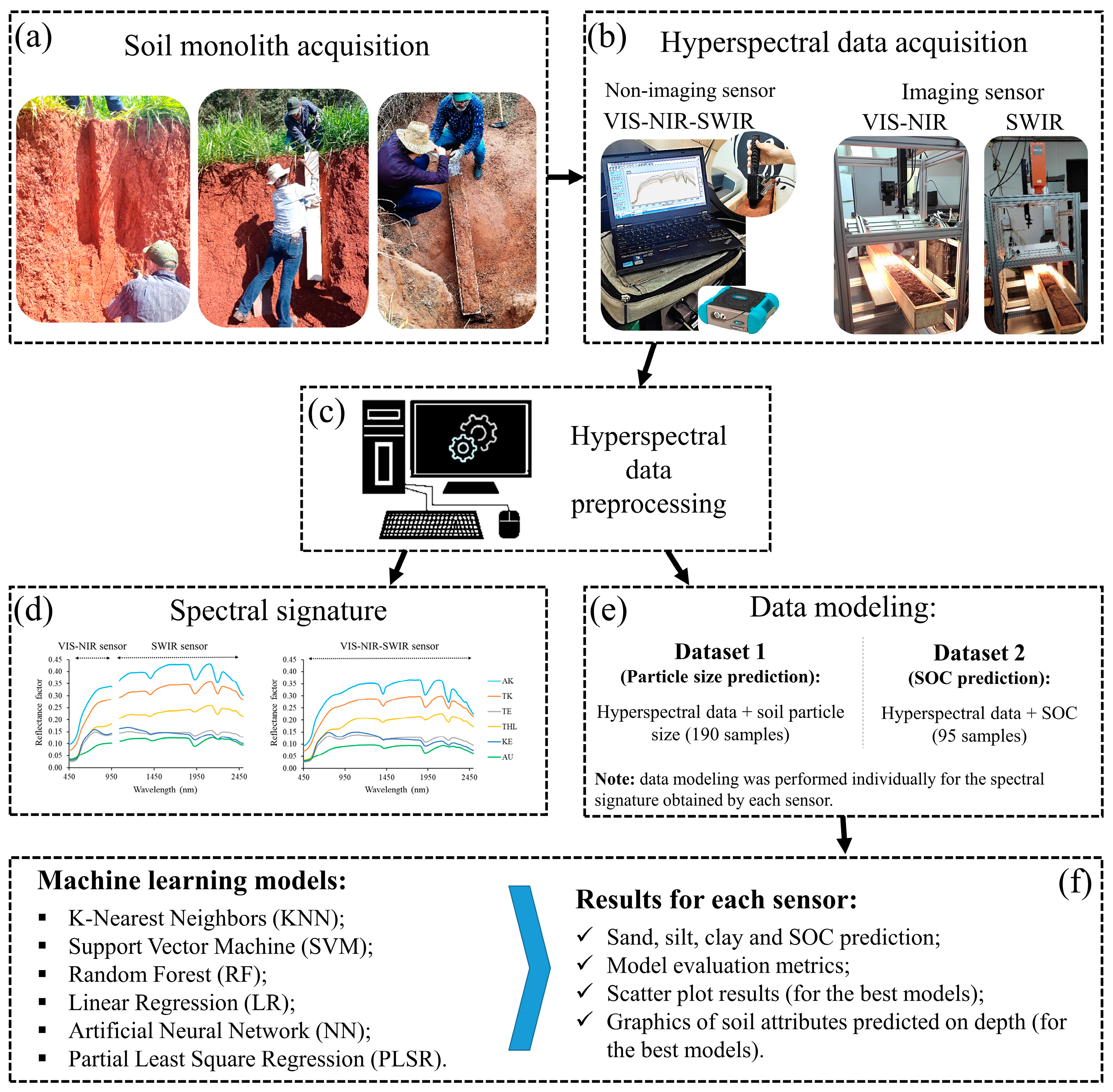


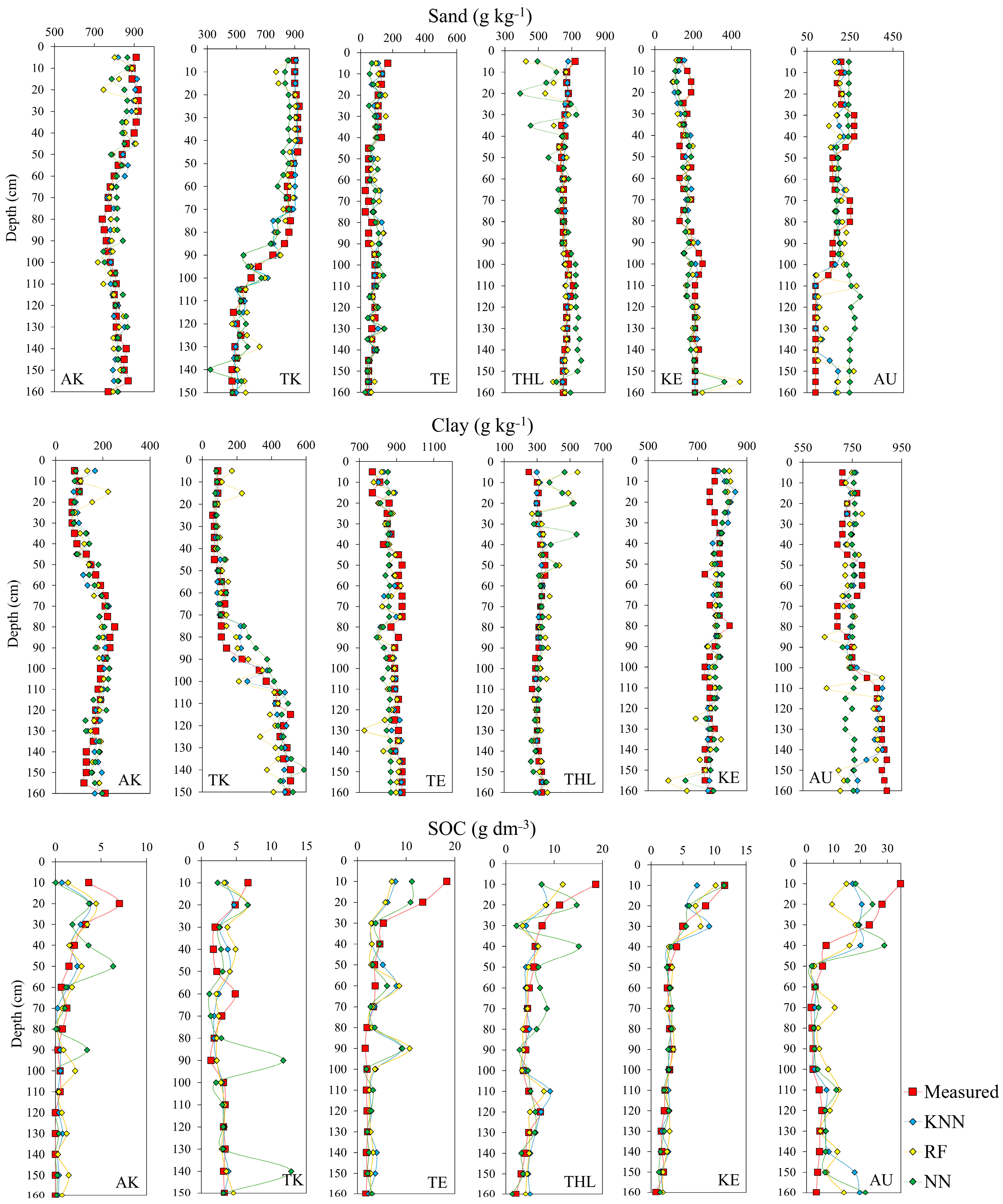
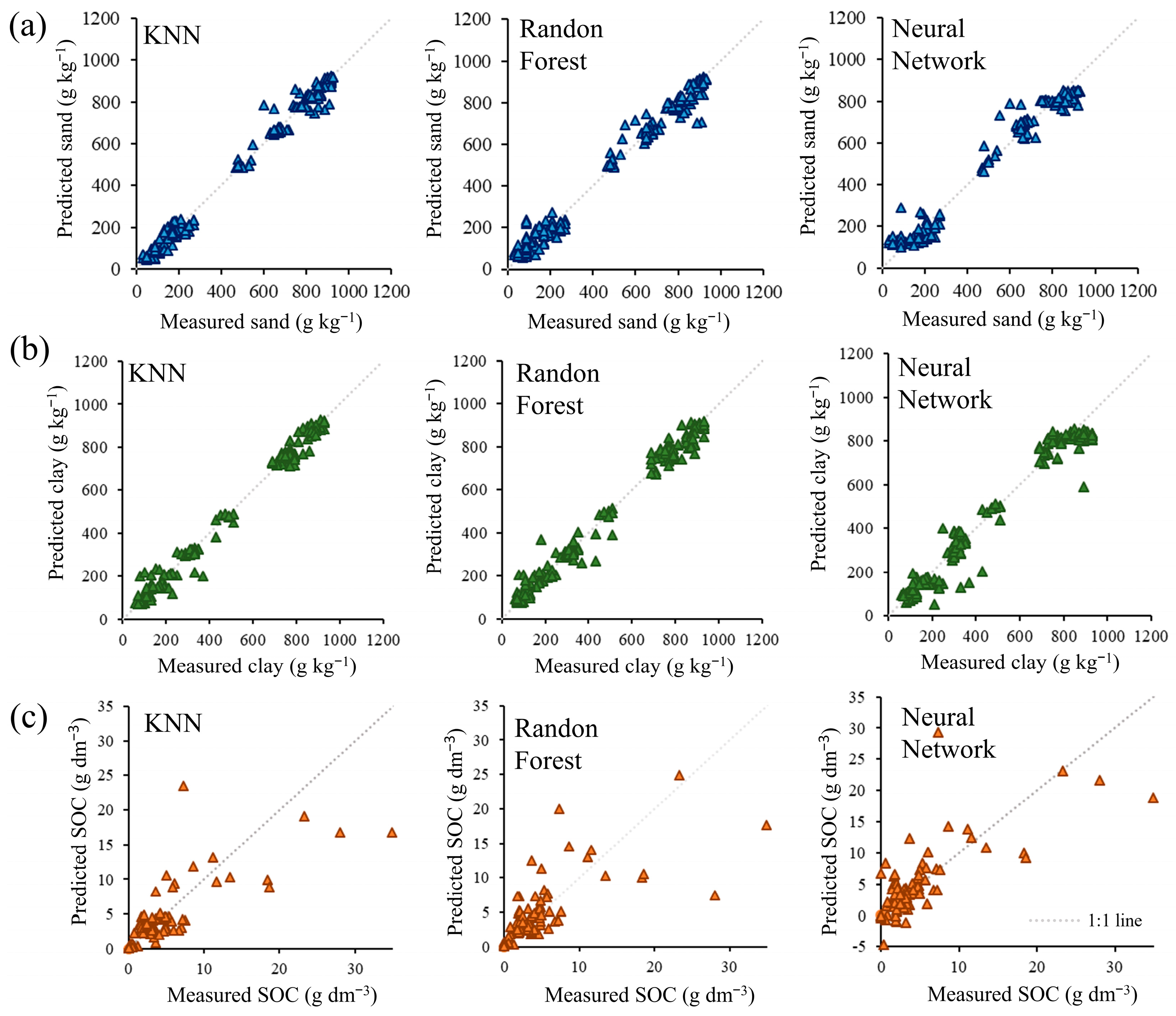
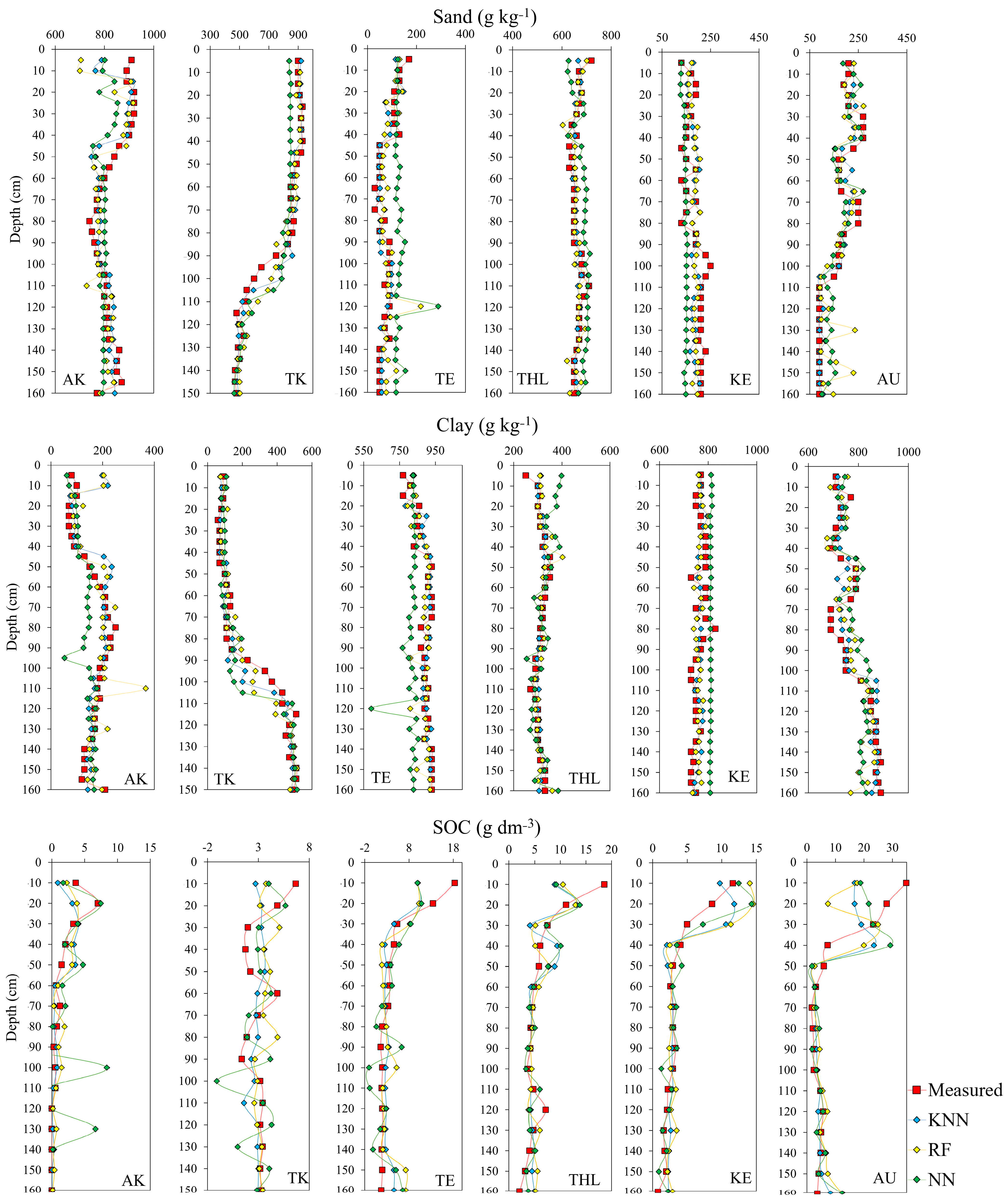

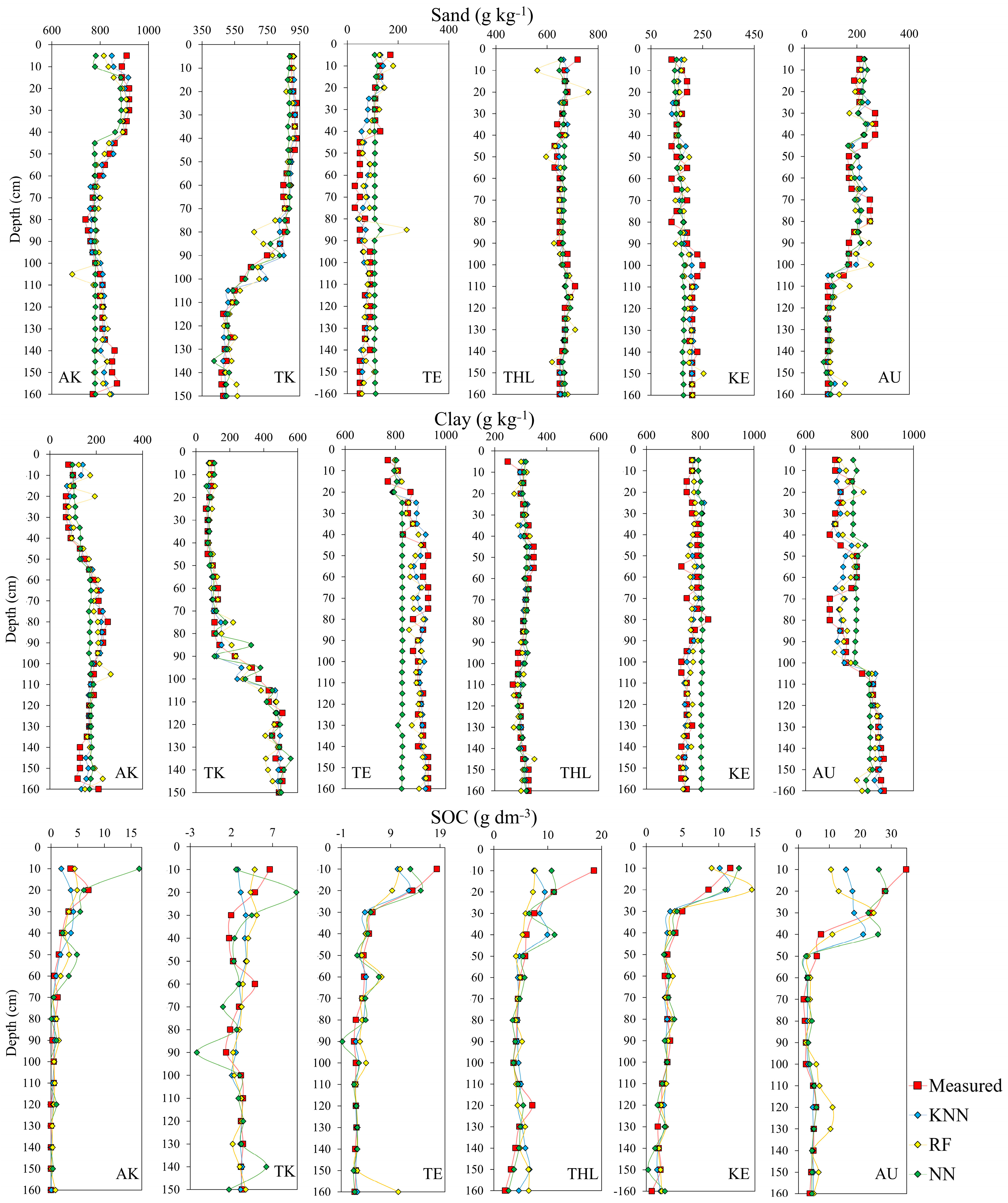
| Taxonomy Units | ID 2 | Layer | n 3 | Sand | Silt | Clay | n 4 | SOC 5 | |
|---|---|---|---|---|---|---|---|---|---|
| SiBCS 1 | Soil Taxonomy | (Part. Size) | Max ± Min (g kg−1) | (SOC) | Max ± Min (g dm−3) | ||||
| Argissolo Vermelho Ta Distrófico | Arenic Kandiustults | AK | Topsoil | 8 | 920 ± 890 | 10 ± 10 | 100 ± 70 | 5 | 7.04 ± 1.49 |
| Subsoil | 24 | 870 ± 740 | 30 ± 10 | 250 ± 120 | 11 | 1.25 ± 0 | |||
| Gleissolo Háplico Ta Distrófico | Typic Kandiaqualfs | TK | Topsoil | 5 | 930 ± 900 | 10 ± 10 | 90 ± 60 | 3 | 6.67 ± 1.98 |
| Subsoil | 25 | 930 ± 470 | 30 ± 10 | 510 ± 70 | 12 | 4.87 ± 1.37 | |||
| Latossolo Vermelho Eutrófico | Typic Eutrudox | TE | Topsoil | 4 | 170 ± 110 | 100 ± 30 | 860 ± 770 | 3 | 18.36 ± 5.35 |
| Subsoil | 28 | 130 ± 30 | 60 ± 10 | 930 ± 830 | 14 | 4.63 ± 1.61 | |||
| Latossolo Vermelho Distrófico | Typic Hapludox Loamy | THL | Topsoil | 7 | 720 ± 640 | 30 ± 20 | 330 ± 250 | 4 | 18.6 ± 6.07 |
| Subsoil | 25 | 710 ± 630 | 40 ± 10 | 350 ± 270 | 12 | 7.16 ± 2.1 | |||
| Nitossolo Vermelho Eutrófico | Kandiudalfic Eutrudox | KE | Topsoil | 8 | 190 ± 130 | 100 ± 60 | 790 ± 750 | 4 | 11.61 ± 4.02 |
| Subsoil | 24 | 250 ± 130 | 80 ± 20 | 830 ± 730 | 11 | 3.3 ± 0.77 | |||
| Gleissolo Háplico Ta Eutrófico | Aquic Udorthents | AU | Topsoil | 5 | 210 ± 190 | 80 ± 40 | 770 ± 710 | 3 | 34.87 ± 23.3 |
| Subsoil | 27 | 270 ± 90 | 80 ± 20 | 890 ± 690 | 13 | 7.28 ± 1.73 | |||
| Total | 190 | 95 | |||||||
| Attributes | Parameters | Model | |||||
|---|---|---|---|---|---|---|---|
| KNN | SVM | RF | LR | NN | PLSR | ||
| Sand | RMSE (g kg−1) | 3.87 | 8.22 | 5.80 | 12.72 | 7.15 | 10.23 |
| RPD | 5.80 | 2.77 | 3.89 | 1.84 | 3.17 | 2.29 | |
| R2 | 0.99 | 0.93 | 0.97 | 0.84 | 0.95 | 0.90 | |
| Silt | RMSE (g kg−1) | 1.35 | 1.75 | 1.44 | 1.77 | 1.62 | 1.47 |
| RPD | 1.20 | 1.04 | 1.15 | 1.03 | 1.08 | 1.13 | |
| R2 | 0.56 | 0.26 | 0.50 | 0.24 | 0.37 | 0.47 | |
| Clay | RMSE (g kg−1) | 4.07 | 8.84 | 6.28 | 12.69 | 6.13 | 10.59 |
| RPD | 5.31 | 2.49 | 3.46 | 1.78 | 3.55 | 2.11 | |
| R2 | 0.98 | 0.92 | 0.96 | 0.83 | 0.96 | 0.88 | |
| SOC | RMSE (g dm−3) | 4.07 | 4.84 | 4.21 | 4.97 | 4.50 | 4.77 |
| RPD | 1.12 | 1.03 | 1.10 | 1.02 | 1.06 | 1.03 | |
| R2 | 0.45 | 0.22 | 0.41 | 0.18 | 0.33 | 0.24 | |
| Attributes | Parameters | Model | |||||
|---|---|---|---|---|---|---|---|
| KNN | SVM | RF | LR | NN | PLSR | ||
| Sand | RMSE (g kg−1) | 3.52 | 10.03 | 4.46 | 10.76 | 5.63 | 10.23 |
| RPD | 6.37 | 2.29 | 5.04 | 2.14 | 4.00 | 2.24 | |
| R2 | 0.99 | 0.90 | 0.98 | 0.88 | 0.97 | 0.90 | |
| Silt | RMSE (g kg−1) | 1.35 | 1.88 | 1.30 | 1.54 | 1.68 | 1.52 |
| RPD | 1.21 | 1.01 | 1.24 | 1.11 | 1.06 | 1.12 | |
| R2 | 0.56 | 0.14 | 0.59 | 0.43 | 0.32 | 0.44 | |
| Clay | RMSE (g kg−1) | 3.43 | 11.24 | 4.06 | 11.01 | 6.47 | 8.83 |
| RPD | 6.30 | 1.98 | 5.32 | 2.02 | 3.36 | 2.48 | |
| R2 | 0.99 | 0.86 | 0.98 | 0.87 | 0.95 | 0.92 | |
| SOC | RMSE (g dm−3) | 3.49 | 4.96 | 3.89 | 4.71 | 3.88 | 3.77 |
| RPD | 1.25 | 1.02 | 1.15 | 1.04 | 1.16 | 1.18 | |
| R2 | 0.60 | 0.19 | 0.50 | 0.26 | 0.50 | 0.53 | |
| Attributes | Parameters | Model | |||||
|---|---|---|---|---|---|---|---|
| KNN | SVM | RF | LR | NN | PLSR | ||
| Sand | RMSE (g kg−1) | 2.88 | 7.16 | 4.17 | 7.89 | 3.74 | 7.94 |
| RPD | 7.80 | 3.17 | 5.39 | 2.88 | 6.00 | 2.86 | |
| R2 | 0.99 | 0.95 | 0.98 | 0.94 | 0.99 | 0.94 | |
| Silt | RMSE (g kg−1) | 1.19 | 1.43 | 1.26 | 1.68 | 1.42 | 1.31 |
| RPD | 1.33 | 1.16 | 1.27 | 1.06 | 1.16 | 1.23 | |
| R2 | 0.66 | 0.50 | 0.62 | 0.32 | 0.51 | 0.59 | |
| Clay | RMSE (g kg−1) | 2.89 | 7.34 | 3.52 | 8.04 | 5.02 | 7.47 |
| RPD | 7.47 | 2.98 | 6.14 | 2.72 | 4.32 | 2.91 | |
| R2 | 0.99 | 0.94 | 0.99 | 0.93 | 0.97 | 0.94 | |
| SOC | RMSE (g dm−3) | 3.30 | 4.06 | 3.80 | 4.89 | 3.05 | 3.86 |
| RPD | 1.30 | 1.12 | 1.17 | 1.02 | 1.39 | 1.15 | |
| R2 | 0.64 | 0.46 | 0.52 | 0.21 | 0.69 | 0.50 | |
Disclaimer/Publisher’s Note: The statements, opinions and data contained in all publications are solely those of the individual author(s) and contributor(s) and not of MDPI and/or the editor(s). MDPI and/or the editor(s) disclaim responsibility for any injury to people or property resulting from any ideas, methods, instructions or products referred to in the content. |
© 2024 by the authors. Licensee MDPI, Basel, Switzerland. This article is an open access article distributed under the terms and conditions of the Creative Commons Attribution (CC BY) license (https://creativecommons.org/licenses/by/4.0/).
Share and Cite
Oliveira, K.M.d.; Gonçalves, J.V.F.; Furlanetto, R.H.; Oliveira, C.A.d.; Mendonça, W.A.; Haubert, D.d.F.d.S.; Crusiol, L.G.T.; Falcioni, R.; Oliveira, R.B.d.; Reis, A.S.; et al. Predicting Particle Size and Soil Organic Carbon of Soil Profiles Using VIS-NIR-SWIR Hyperspectral Imaging and Machine Learning Models. Remote Sens. 2024, 16, 2869. https://doi.org/10.3390/rs16162869
Oliveira KMd, Gonçalves JVF, Furlanetto RH, Oliveira CAd, Mendonça WA, Haubert DdFdS, Crusiol LGT, Falcioni R, Oliveira RBd, Reis AS, et al. Predicting Particle Size and Soil Organic Carbon of Soil Profiles Using VIS-NIR-SWIR Hyperspectral Imaging and Machine Learning Models. Remote Sensing. 2024; 16(16):2869. https://doi.org/10.3390/rs16162869
Chicago/Turabian StyleOliveira, Karym Mayara de, João Vitor Ferreira Gonçalves, Renato Herrig Furlanetto, Caio Almeida de Oliveira, Weslei Augusto Mendonça, Daiane de Fatima da Silva Haubert, Luís Guilherme Teixeira Crusiol, Renan Falcioni, Roney Berti de Oliveira, Amanda Silveira Reis, and et al. 2024. "Predicting Particle Size and Soil Organic Carbon of Soil Profiles Using VIS-NIR-SWIR Hyperspectral Imaging and Machine Learning Models" Remote Sensing 16, no. 16: 2869. https://doi.org/10.3390/rs16162869
APA StyleOliveira, K. M. d., Gonçalves, J. V. F., Furlanetto, R. H., Oliveira, C. A. d., Mendonça, W. A., Haubert, D. d. F. d. S., Crusiol, L. G. T., Falcioni, R., Oliveira, R. B. d., Reis, A. S., Ecker, A. E. d. A., & Nanni, M. R. (2024). Predicting Particle Size and Soil Organic Carbon of Soil Profiles Using VIS-NIR-SWIR Hyperspectral Imaging and Machine Learning Models. Remote Sensing, 16(16), 2869. https://doi.org/10.3390/rs16162869








